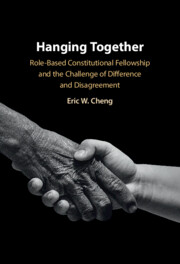 Hanging Together
Hanging Together Book contents
- Hanging Together
- Hanging Together
- Copyright page
- Contents
- Acknowledgments
- 1 Introduction
- 2 Aiming Too High, Aiming Too Low
- 3 Fellowship’s Forefather
- 4 Broadening the Base
- 5 Three Dimensions of Trust
- 6 Principled Pragmatists, Principled Purists, and the Liberal Democratic Front
- 7 Talking, Shouting Back, and Listening Better
- 8 Justifying (and Constraining) Salutary Hypocrisy
- 9 Facilitating Fellowship
- 10 Conclusion
- Index
8 - Justifying (and Constraining) Salutary Hypocrisy
Published online by Cambridge University Press: 07 July 2022
- Hanging Together
- Hanging Together
- Copyright page
- Contents
- Acknowledgments
- 1 Introduction
- 2 Aiming Too High, Aiming Too Low
- 3 Fellowship’s Forefather
- 4 Broadening the Base
- 5 Three Dimensions of Trust
- 6 Principled Pragmatists, Principled Purists, and the Liberal Democratic Front
- 7 Talking, Shouting Back, and Listening Better
- 8 Justifying (and Constraining) Salutary Hypocrisy
- 9 Facilitating Fellowship
- 10 Conclusion
- Index
Summary
Chapter 8 discusses how trust can emerge between the formal political sphere and the general citizenry. Returning to the discussion of salutary hypocrisy, the chapter notes that people generally distrust hypocrisy. So, even though salutary hypocrisy can facilitate compromise and trust among political actors, that hypocrisy can simultaneously aggravate distrust between political actors and citizens at large. Accordingly, this chapter argues that political actors (principled pragmatists in particular) must justify their apparent hypocrisy and take steps to avoid needlessly aggravating citizens’ cynicism. The chapter suggests that political actors should refrain from excessively demonizing one another, explain why they struck compromises (but only after the fact and with care), and avoid encouraging citizens to develop fantastical understandings of politics.
Keywords
- Type
- Chapter
- Information
- Hanging TogetherRole-Based Constitutional Fellowship and the Challenge of Difference and Disagreement, pp. 141 - 155Publisher: Cambridge University PressPrint publication year: 2022
